ITALY
BALANZONE - Bologna
The name Balanzone seems to be coming from "balle" (lies), and gives well the idea of this mask, which pretends to have a total knowledge, supported by his science, arrogance and ignorance.
Born in Bologna, at the time in which the University was well established in the capital of Emilia (second half of 16th century).
Balanzone is rather fat (fat = rich), always dresses in black, is well groomed, rich looking, and talks and talks, a river of ostentatious useless science, teasing the current exaggerated belief in science and humanism.
The Doctor is the second old folk together with Pantaloon in the Commedia dell'Arte, and first appears on stage in the mid 16th century, with the name of Graziano (or Grazian Baloardo), which later became Dottor Balanzone.
The Doctor character is normally used in the Commedia dell'Arte plays to put a break in the action, with empty, pre-fabricated and supposedly erudite monologues.
Sort of a drums or bass solo in Jazz, which gives the time to the other musicians to take a break and go drink something or put a new reed on their saxophone.
The Doctor is member of every academy (known or unknown) he knows everything and makes citations in cultivated Greek or Latin, too bad they are never right.
On stage he is very seldom a medicine doctor for real, he more often impersonates a Lawyer, a Judge, or the Notary Public.
Popular belief, hostility toward these "I know everything" characters, shows how the "Commedia dell'Arte" used to characterize and make irony on everyday life, pulling the leg on every established belief, anarchic force in a rigid and schematic world, with the typical Italian humor and self-irony.
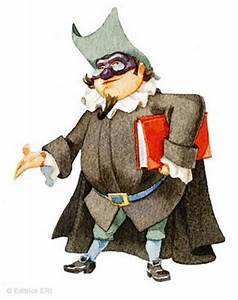
PULCINELLA - Naples
Since ancient times, the mask represented different folkloric attitudes; for example, during the Early Christian age, it was symbol of the natural forces, as well as of the animal and dead world. But in the late Middle Ages it was used both to exorcise hierarcical figures and to get a poetical function, especially in the courts.
In Naples, “Pulcinella” mask has got very old origins. It appeared for the very first time in 1300, when its name stood for “little chick” and was used to indicate an idler and timewaster person. Then, its origins were attribuited to Silvio Fiorillo, a dramatist of 1500 who, during its performances, used to wear a kind of mask completely different from the one we know today; it is, in fact, a typical “mid mask”, also called “lupo” with a big bent nose, a face full of wrinkles and very small eyes.
These particular characteristics, together with a shrill voice, make the mask more similar to a black grouse, from which the word “polleciniello” (in Neapolitan dialect) comes from.
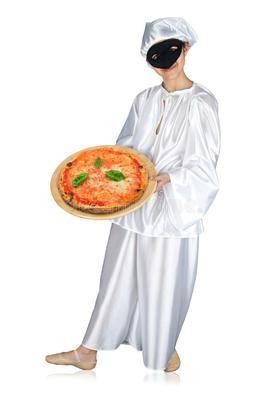
ARLECCHINO - Bergamo
Harlequin is a fool and a gullible Mask, a servant which can be compared to those found in the Greek New Comedy and in the Latin Comedy. But unlike slaves in ancient comedies, though, Harlequin does not occasionally give good advice to his master, but rather always end up being beaten because of something he hasn’t done at all.
From the 16th century onwards, anyway, this craven and constantly hungry and penniless Mask starts turning into the greedy and shrewd page of a noblesman, in love with some maidservant and with a tone definitely more lifelike than coarse.
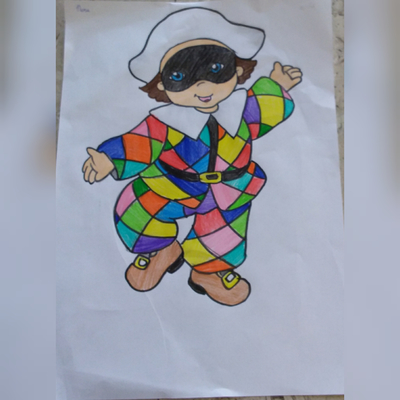
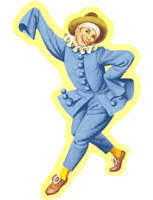 PEPPE NAPPA -SICILY
PEPPE NAPPA -SICILY
Peppe Nappa or Beppe Nappa is the oldest Sicilian mask whose name “Peppi”, in Sicilian dialect, comes from Giuseppe, while “nappa” denotes the darn in his socks. So the name in full means “John darn in his socks” or, in other words, a good for nothing. His stage costume has a baggy blue jacket, trousers and a felt hat. He is without a mask or particular make up. He is extremely greedy and never stops stuffing himself so he loves being in the kitchen where he can taste his favourite food. In the stories he is often a lazy servant figure who nonetheless manages to astound spectators with his tricks
Papà del Gnoco – Carnevale di Verona
The Verona Carnival has ancient origins:
it can be considered the most ancient carnivals in Europe.
Every year it involves the entire Veronese population
and the San Zeno district, in particular.
The Carnival of Verona, formerly called Bacanàl del Gnoco,
dates back to the time of Tomaso da Vico, a 16th century
doctor who wrote in his will, the obligation to distribute
food and food for the population in poverty
to the population of the San Zeno district every year.
In fact, in the "Istoria Veronese" written by Girolamo Dalla Corte,
it is written that, due to devastating floods of the Adige river,
which took place in 1520-1531, and the devastation caused by
the Lanzichenecchi of Carlo V, the city of Verona suffered a great famine.
For this reason the bakers ("pistori"), who could no longer find
the flour, had increased the price of bread and, failing to sell it,
had stopped production.
On June 18, 1531, the people of the San Zeno district rose up and gave assault to the bakers to grab bread and wheat. 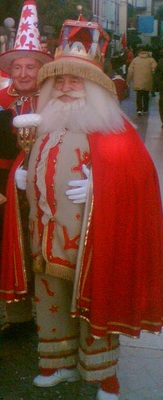 Some citizens, including Tomaso da Vico, decided to help the poorest inhabitants of the neighborhood. In the square of San Zeno, in Verona, there is still today a stone table: here the poor were invited on the Friday before Lent, called "Venardi Consolàr" (Friday Comforter).
Some citizens, including Tomaso da Vico, decided to help the poorest inhabitants of the neighborhood. In the square of San Zeno, in Verona, there is still today a stone table: here the poor were invited on the Friday before Lent, called "Venardi Consolàr" (Friday Comforter). 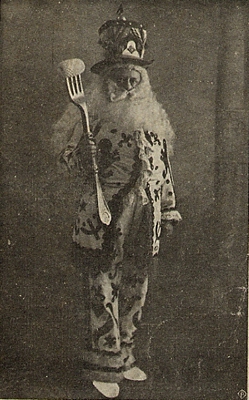 The Carnival is a wonderful party that involves and excites all the people of Verona. There are always many events scheduled, but the most important is the Venare Gnocolar parade, with allegorical floats and more than seven thousand masked figures. The cheerful procession crosses the historic center of Verona. The mask of the Papa de’ Gnoco leads the parade of masks along the streets of the city. The Gnoco Dad is a king with a big belly and a thick white beard, as a scepter he holds in his hand a gigantic fork that pierces a huge dumpling. El gnoco has become one of the main delicacies of Veronese cuisine and is eaten mainly during Lent, when the Catholic tradition advises not to eat meat, at least on Friday.
The Carnival is a wonderful party that involves and excites all the people of Verona. There are always many events scheduled, but the most important is the Venare Gnocolar parade, with allegorical floats and more than seven thousand masked figures. The cheerful procession crosses the historic center of Verona. The mask of the Papa de’ Gnoco leads the parade of masks along the streets of the city. The Gnoco Dad is a king with a big belly and a thick white beard, as a scepter he holds in his hand a gigantic fork that pierces a huge dumpling. El gnoco has become one of the main delicacies of Veronese cuisine and is eaten mainly during Lent, when the Catholic tradition advises not to eat meat, at least on Friday.